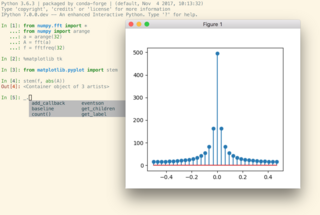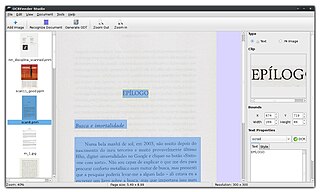Python is an interpreted, high-level and general-purpose programming language. Created by Guido van Rossum and first released in 1991, Python's design philosophy emphasizes code readability with its notable use of significant whitespace. Its language constructs and object-oriented approach aim to help programmers write clear, logical code for small and large-scale projects.

A quine is a computer program which takes no input and produces a copy of its own source code as its only output. The standard terms for these programs in the computability theory and computer science literature are "self-replicating programs", "self-reproducing programs", and "self-copying programs".
In computer programming, standard streams are interconnected input and output communication channels between a computer program and its environment when it begins execution. The three input/output (I/O) connections are called standard input (stdin), standard output (stdout) and standard error (stderr). Originally I/O happened via a physically connected system console, but standard streams abstract this. When a command is executed via an interactive shell, the streams are typically connected to the text terminal on which the shell is running, but can be changed with redirection or a pipeline. More generally, a child process inherits the standard streams of its parent process.
Message Passing Interface (MPI) is a standardized and portable message-passing standard designed by a group of researchers from academia and industry to function on a wide variety of parallel computing architectures. The standard defines the syntax and semantics of a core of library routines useful to a wide range of users writing portable message-passing programs in C, C++, and Fortran. There are several well-tested and efficient implementations of MPI, many of which are open-source or in the public domain. These fostered the development of a parallel software industry, and encouraged development of portable and scalable large-scale parallel applications.

SciPy is a free and open-source Python library used for scientific computing and technical computing.

NumPy is a library for the Python programming language, adding support for large, multi-dimensional arrays and matrices, along with a large collection of high-level mathematical functions to operate on these arrays. The ancestor of NumPy, Numeric, was originally created by Jim Hugunin with contributions from several other developers. In 2005, Travis Oliphant created NumPy by incorporating features of the competing Numarray into Numeric, with extensive modifications. NumPy is open-source software and has many contributors.
Psyco was a specializing just-in-time compiler for Python originally developed by Armin Rigo and further maintained and developed by Christian Tismer. Development ceased in December, 2011.
CherryPy is an object-oriented web application framework using the Python programming language. It is designed for rapid development of web applications by wrapping the HTTP protocol but stays at a low level and does not offer much more than what is defined in RFC 7231.
Charm++ is a parallel object-oriented programming paradigm based on C++ and developed in the Parallel Programming Laboratory at the University of Illinois at Urbana–Champaign. Charm++ is designed with the goal of enhancing programmer productivity by providing a high-level abstraction of a parallel program while at the same time delivering good performance on a wide variety of underlying hardware platforms. Programs written in Charm++ are decomposed into a number of cooperating message-driven objects called chares. When a programmer invokes a method on an object, the Charm++ runtime system sends a message to the invoked object, which may reside on the local processor or on a remote processor in a parallel computation. This message triggers the execution of code within the chare to handle the message asynchronously.

Launchy is a free and open-source application launcher for Windows, Mac OS X, FreeBSD and Linux. It indexes shortcuts in the start menu, and files in specific folders, to allow quicker access to programs without opening the start menu or browsing to folders.

IPython is a command shell for interactive computing in multiple programming languages, originally developed for the Python programming language, that offers introspection, rich media, shell syntax, tab completion, and history. IPython provides the following features:
Web2py is an open-source web application framework written in the Python programming language. Web2py allows web developers to program dynamic web content using Python. Web2py is designed to help reduce tedious web development tasks, such as developing web forms from scratch, although a web developer may build a form from scratch if required.

Cython is a programming language that aims to be a superset of the Python programming language, designed to give C-like performance with code that is written mostly in Python with optional additional C-inspired syntax.
The Python for S60 also called PyS60, was Nokia’s port of the general Python programming language to its S60 software platform, originally based on Python 2.2.2 from 2002. The latest final version, PyS60-2.0.0, released on 11 February 2010 updated the python core to version 2.5.4.
PyQuante is an open-source (BSD) suite of programs for developing quantum chemistry methods using Gaussian type orbital (GTO) basis sets. The program is written in the Python programming language, but has "rate-determining" modules written in C for speed, and also uses and requires the NumPy linear algebra extensions to Python. The resulting code, though not as fast as other quantum chemistry programs, is much easier to understand and modify. The goal of this software is not necessarily to provide a working quantum chemistry program but rather to provide a set of tools so that scientists can construct their own quantum chemistry programs without going through the tedium of having to write every low-level routine.

OCRFeeder is an optical character recognition suite for GNOME, which also supports virtually any command-line OCR engine, such as CuneiForm, GOCR, Ocrad and Tesseract. It converts paper documents to digital document files and can serve to make them accessible to visually impaired users.
Programming with Big Data in R (pbdR) is a series of R packages and an environment for statistical computing with big data by using high-performance statistical computation. The pbdR uses the same programming language as R with S3/S4 classes and methods which is used among statisticians and data miners for developing statistical software. The significant difference between pbdR and R code is that pbdR mainly focuses on distributed memory systems, where data are distributed across several processors and analyzed in a batch mode, while communications between processors are based on MPI that is easily used in large high-performance computing (HPC) systems. R system mainly focuses on single multi-core machines for data analysis via an interactive mode such as GUI interface.

Hy is a dialect of the Lisp programming language. It is designed to interact with the language Python by translating expressions into Python's abstract syntax tree (AST). Hy was introduced at Python Conference (PyCon) 2013 by Paul Tagliamonte.
The GEKKO Python package solves large-scale mixed-integer and differential algebraic equations with nonlinear programming solvers. Modes of operation include machine learning, data reconciliation, real-time optimization, dynamic simulation, and nonlinear model predictive control. In addition, the package solves Linear programming (LP), Quadratic programming (QP), Quadratically constrained quadratic program (QCQP), Nonlinear programming (NLP), Mixed integer programming (MIP), and Mixed integer linear programming (MILP). GEKKO is available in Python and installed with pip from PyPI of the Python Software Foundation.







